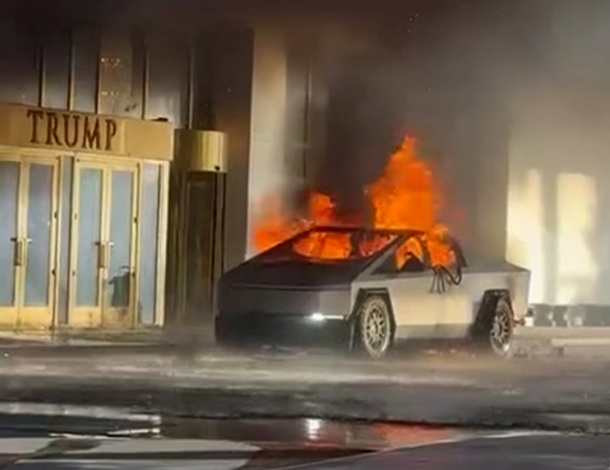By: Aarav Sapra
Elon Musk and Donald Trump have often been recognized as two influential partners who have supported each other numerous times during the election cycle. For instance, Musk backed Trump by funding multiple campaigns to help Trump triumph in the 2024 Presidential Elections. On the other hand, Trump has backed Musk’s stance on the H-1B Visa program, a crucial tool for attracting skilled talent to tech companies. However, ironically, on a bizarre morning in Las Vegas, a Tesla Cybertruck exploded outside the Trump Hotel on Jan. 1, 2025. The distinctive, triangular shape of the Cybertruck, parked near the hotel’s entrance, was reportedly engulfed in flames after a sudden and violent explosion. The Cybertruck had pulled up to the hotel and then proceeded only to blow up. Fortunately, firefighters were on the scene quickly, extinguishing the blaze before it could spread to nearby vehicles or the hotel itself. After the incident was cleared up, authorities stated they found fuel canisters, fireworks and two semi-automatic handguns. Regardless, they could not figure out how the explosion had been ignited.
Although people speculated the truck exploded due to issues in the vehicle, Musk made it quite clear the explosion was caused by the massive fireworks or bomb that was in the bed of the truck. A couple of days later, military officials identified the driver as Army Master Sergeant Matthew Alan Livelsberger. According to the Army, Sergeant Livelsberger enlisted as a Special Forces trainee, and served on active duty from January 2006 to March 2011. Afterwards, he was enrolled in the National Guard from March 2011 to July 2012, and later became an Army Reservist from July 2012 to December 2012. He had rented the Tesla truck in Denver on Dec. 28 and passed through Colorado, New Mexico, and Arizona before arriving in Las Vegas and parking in front of the Trump hotel. He supposedly detonated the explosives, and shot himself soon after.
According to notes on Sergeant Livelsberger’s cell phone, which were shared publicly by the police, he had been concerned that the United States was headed toward “collapse.” One note stated, “This was not a terrorist attack. It was a wake-up call. Americans only pay attention to spectacles and violence. What better way to get my point across than a stunt with fireworks and explosives?” Ultimately, this has resulted in the community speculating that the explosion may have been an act of protest or intentional sabotage, which supports Livelsberger’s beliefs. Others dismiss this theory, claiming it is more likely a coincidence. Given the high-profile nature of both Tesla and Trump, it is hard to ignore many potential theories that still may exist.

